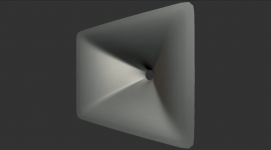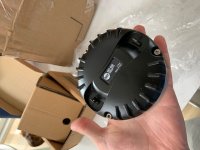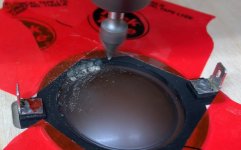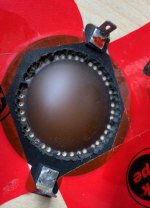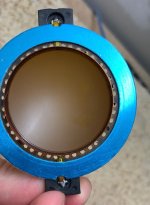Apart from the beaks and (Bi-)Radial horn walls, the 4367 horn isn't very different from Meyer Sound's Acheron Horn.
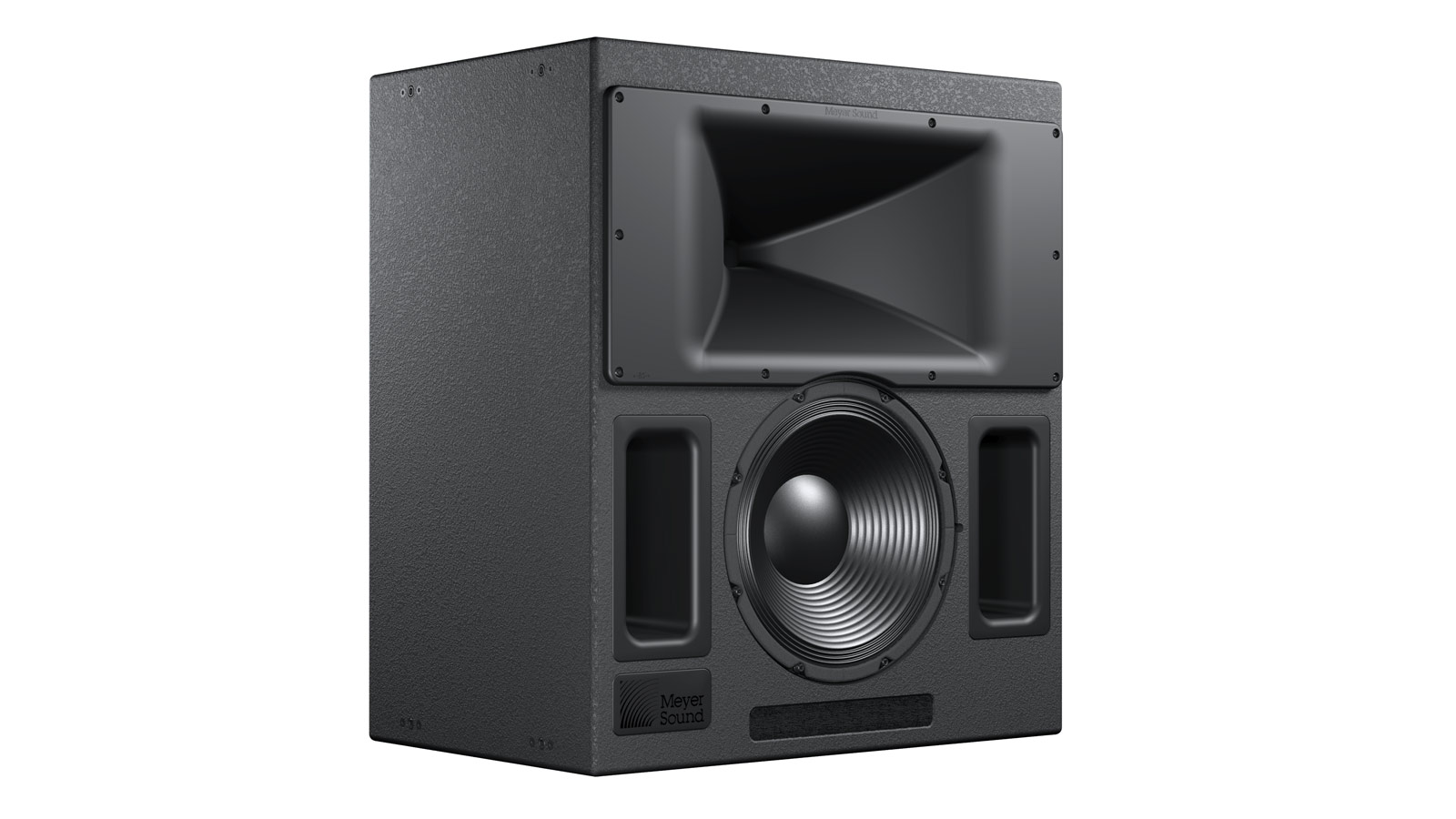

Last edited:
In experimenting with mabat's tools I've found when extreme .exp values are entered, the onset of trenches become visible, similar to those in the 4367's horn (up and below the throat).
Somebody with exceptional parametric modeling capabilities would probably be able to develop a tool, or parametrized CAD model - including the required math - to reproduce (and even improve upon) the JBL Image Control Waveguides.
mabat's tools reproduce an OS throat section, which is still visible in the horizontal plane, where the trenches are less pronounced.
I believe the beaks of the JBL waveguides are 'brought in' from the the mouth. There's a short 'slotted throat section' - basically similar to the throat section of the latest Meyer horns - that's modified in accordance with the required/desired 'smearing of reflections'.
Somebody with exceptional parametric modeling capabilities would probably be able to develop a tool, or parametrized CAD model - including the required math - to reproduce (and even improve upon) the JBL Image Control Waveguides.
mabat's tools reproduce an OS throat section, which is still visible in the horizontal plane, where the trenches are less pronounced.
I believe the beaks of the JBL waveguides are 'brought in' from the the mouth. There's a short 'slotted throat section' - basically similar to the throat section of the latest Meyer horns - that's modified in accordance with the required/desired 'smearing of reflections'.
Attachments
Last edited:
Another way of looking at the Image Control Waveguides is as follows:
The basis is a parameterized, fully closed bi-radial horn - so with an infinitely small throat size - into which the required driver exit is then pressed.
Finally, a key-element in cancelling interferences is the intentional creation of pathlength differences.
If you visualize an (imaginary) extension of the 4367 horn's horizontal walls into the throat, it's obvious that the beaks (or knuckles) would meet 'in front of the vertical walls'.
The 'magic' of the Image Control Waveguides is in the throat section.
The basis is a parameterized, fully closed bi-radial horn - so with an infinitely small throat size - into which the required driver exit is then pressed.
Finally, a key-element in cancelling interferences is the intentional creation of pathlength differences.
If you visualize an (imaginary) extension of the 4367 horn's horizontal walls into the throat, it's obvious that the beaks (or knuckles) would meet 'in front of the vertical walls'.
The 'magic' of the Image Control Waveguides is in the throat section.
Last edited:
Finally, a key-element in cancelling interferences is the intentional creation of pathlength differences.
Should be:
Finally, a key-element in cancelling interferences is the intentional creation of varying pathlength parameters.
Utilizing COMSOL's Acoustics Module you could eventually optimize the 'crude waveguide shape' in accordance with the required constraints (mentioned by Elgray).
For this purpose a lumped parameter model of the driver is required.
However, it appears that the older JBL drivers - which are technically completely different from the 2430K - also work well with the M2 Waveguide.
Last edited:
Ro808 qoute: Diffraction is intrisic to every horn and waveguide
Reply
This has got me very curious as I really want to like horns - Can someone suggest a HF horn with driver that is "almost diffraction free", ready to be intigrated with a LF driver?
My ES-1200 Biradial is free from edge diffraction so as I can measure using ARTA’s burst decay waterfall plot and off-axis coloured polar maps.
https://josephcrowe.com/collections/custom-speakers-designed-built-to-order/products/es-1200-bi-radial-wood-horn
Why do JBL's Image Control Waveguides excel?
Because these are diffraction horns.
What does that have to do with it?? The real issue is just how audible diffraction artifacts are. As far as I know there is no metric and until there is one have to trust your ears not your eyes.
Rob 🙂
What does that have to do with it?? The real issue is just how audible diffraction artifacts are. As far as I know there is no metric and until there is one have to trust your ears not your eyes.
Rob 🙂
Every time I go through a horn design revision where acoustical stored energy is minimized further (confirmed by measurement) then there is a corresponding improvement in the subjective sound quality. After you do this multiple times you become convinced that there is an audible effect.
@ Joseph. If those sound as good as they look, then

Thanks! I'm working on a scaled up version ES-600 right now using the RCF ND-650.
ES-600 Bi-Radial Wood Horn – Joseph Crowe
Attachments
There is so much going on there, I don't know where to start.
- Rear chamber
- Polar response
- Stored energy
- Big blocks of walnut
There is so much going on there, I don't know where to start.
I'll ask about stored energy and about the rear chamber as those are areas I've experimented with. I got nowhere with changing the rear chambers on Altec drivers. I have heard sand filled and tar filled horns and know that they sounded exceptionally clean. But you might mean something else.
- Rear chamber
- Polar response
- Stored energy
- Big blocks of walnut
Thanks. I think all of your questions can be answered by reading one of my blog posts that walks through the changes step by step starting with the stock driver, then adding the modified diaphragms, then adding the rear chamber. Each time there is a measurable improvement. I've attached pictures of the modified diaphragm where I remove 50% of the material from the surround using a V-Cutter on my CNC machine. This lowers the FS to allow the bandwidth to extend down to 1200Hz.
Joseph Crowe's DIY Speaker Building Blog: ES-1200 Biradial Wood Horn
Attachments
What does that have to do with it?? The real issue is just how audible diffraction artifacts are. As far as I know there is no metric and until there is one have to trust your ears not your eyes.
Rob 🙂
This was just an observation.
The excellent properties of JBL's IC and PT waveguides are primarily the result of the slots, even though these are sometimes hardly visible.
Actually, I am not in the least interested in, nor discouraged by 'qualitative connotations' related to horn/waveguide types.
By only focusing on a specific approach, other options are excluded, which seriously hampers progress.
Last edited:
Thanks. I think all of your questions can be answered by reading one of my blog posts that walks through the changes step by step starting with the stock driver, then adding the modified diaphragms, then adding the rear chamber. Each time there is a measurable improvement. I've attached pictures of the modified diaphragm where I remove 50% of the material from the surround using a V-Cutter on my CNC machine. This lowers the FS to allow the bandwidth to extend down to 1200Hz.
Joseph Crowe's DIY Speaker Building Blog: ES-1200 Biradial Wood Horn
Looking good, Joseph!
Are you familiar with this brand?
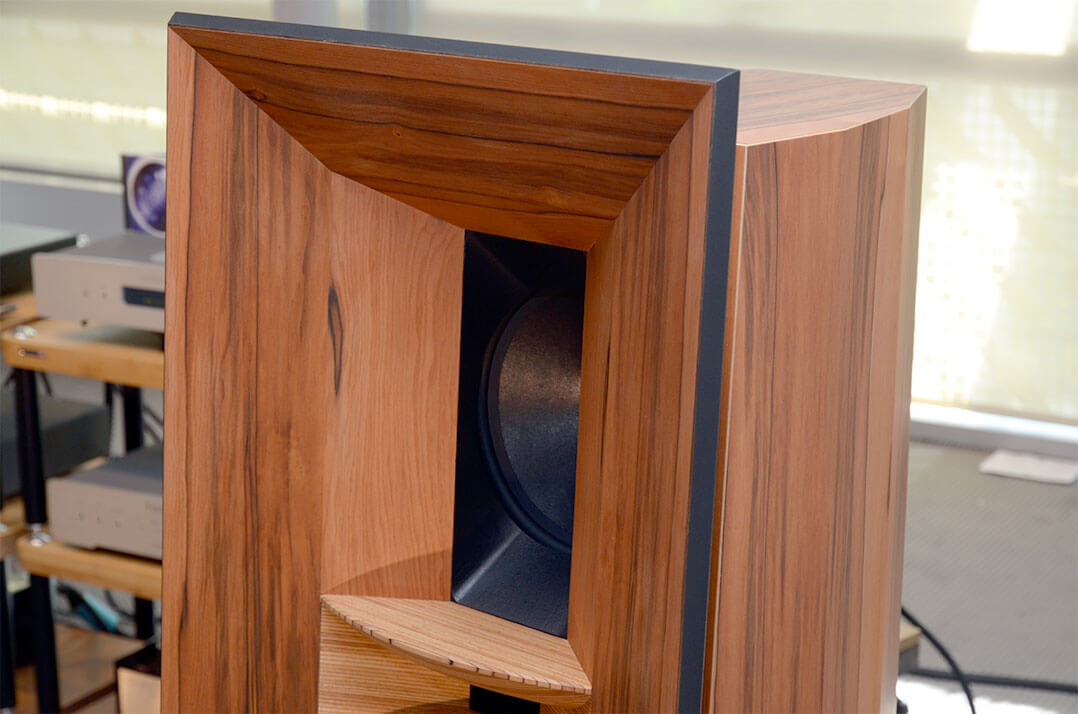

Every time I go through a horn design revision where acoustical stored energy is minimized further (confirmed by measurement)
Can you show those measurements and how you came to that conclusion? I might tend to agree with it, but I cannot imagine how you would actually measure this. Of course by "stored energy" I assume that you mean resonances.
If you do this mechanically then how did you show what the actual sound radiation effect is? These would not be easy measurements/calculations.
This was just an observation.
The excellent properties of JBL's IC and PT waveguides is primarily the result of the slots, even though these are sometimes hardly visible.
Actually, I am not in the least interested in, nor discouraged by 'qualitative connotations' related to horn/waveguide types.
By only focusing on a specific approach, other options are excluded, which seriously hampers progress.
This is just a hunch, pure speculation...but I think JBL's design works because the diffraction occurs so early in the impulse response. There must be less than 50mm between the diaphragm and the diffraction zone. This is less than 0.15ms when looking at the speed of sound. The driver hasn't even stopped moving at this point. That's why I like looking at the time domain aspect since it reveals a lot about the system. JBL certainly hasn't excluded diffraction as a means to and end. They've worked around the various pitfalls of that this 'type' may bring if poorly designed. So I'm 100% agreeing with your sentiments.
Last edited:
Can you show those measurements and how you came to that conclusion? I might tend to agree with it, but I cannot imagine how you would actually measure this. Of course by "stored energy" I assume that you mean resonances.
If you do this mechanically then how did you show what the actual sound radiation effect is? These would not be easy measurements/calculations.
Hi Mr. Geddes, please take a look at my blog post. Please let me know if there are other questions still stemming from my comments.
Joseph Crowe's DIY Speaker Building Blog: ES-1200 Biradial Wood Horn
I have another blog post that may be of interest too where I compare the ES-800 against the B&C ME20 Constant Directivity horn. Please feel free to comment or ask questions.
Joseph Crowe's DIY Speaker Building Blog: ES-800 Biradial Wood Horn
Can you show those measurements and how you came to that conclusion? I might tend to agree with it, but I cannot imagine how you would actually measure this. Of course by "stored energy" I assume that you mean resonances.
If you do this mechanically then how did you show what the actual sound radiation effect is? These would not be easy measurements/calculations.
Previously, when heavy versus light cones were discussed, I was tempted to post the following. Now it seems more appropriate.
Whenever "energy storage" pops up, I am often reminded of an old interview with Joachim Gerhard, from which this fragment was copied:
Question: What would you like to improve with low range drivers?
J.G.: We would get several advantages if we could increase the effective area of the driver without losing control over the radiation pattern. And also lowering the mass, make stronger magnet systems and harder, lighter cones.
Question: Many "old" paper woofers still sound astonishingly good compared to modern drivers?
J.G.: Oh, yes. We have not always went to the better. What many driver manufacturers have done the last years, is to increase the damping to make the frequency response more flat. But some old drivers, like the famous 6,5" paper woofer that Jan Paus at Seas made several years ago, (The Seas CA 17 RCY, ed. note) was optimized for low loss. So they made a compromise between frequency response and sensitivity. This driver was very good, and was used by Wilson Audio for many years. Later, in the 80's, manufacturers started to add more mass, they added more damping, and they made surrounds with high loss. That gave an extremely flat frequency response, but also a lot of energy storage. This compared, the old drivers were much quicker. They had some resonances, but you could get rid of that in the crossover. It was this run for flat response that gave a lot of modern drivers this dull, uninteresting sound. And you can also measure higher second and third harmonic distortion in some of them. If you compare the on-axis response between an old and new driver; you will see that the energy in the treble is far higher than in the new drivers. These so-called "modern" drivers often has a Qms of maybe 0.8 or 0.6. The old drivers had Qms values of maybe 5 to 7! We found that drivers with a very high mechanical Q sound more open, more clean and dynamic. And when you look at it, you find it is very simple, because they have less loss. The surround is easier to move, the spider is better constructed, they have better air flow, higher sensitivity. So a high mechanical Q is a very good indicator of energy storage behavior. This is one of our secrets. One of the many!
Last edited:
Hi Mr. Geddes, please take a look at my blog post. Please let me know if there are other questions still stemming from my comments.
Joseph Crowe's DIY Speaker Building Blog: ES-1200 Biradial Wood Horn
I have another blog post that may be of interest too where I compare the ES-800 against the B&C ME20 Constant Directivity horn. Please feel free to comment or ask questions.
Joseph Crowe's DIY Speaker Building Blog: ES-800 Biradial Wood Horn
You've achieved impressive results with the modded DE-400TN and your horn


Makes me want to buy a pair of DE 400TNs from a guy who has stored many of those in as good as new condition.
Last edited:
- Home
- Loudspeakers
- Multi-Way
- Is it possible to cover the whole spectrum, high SPL, low distortion with a 2-way?
